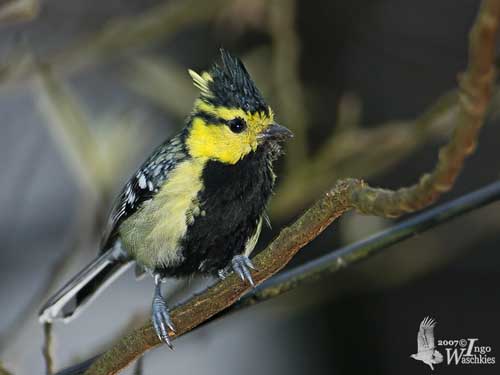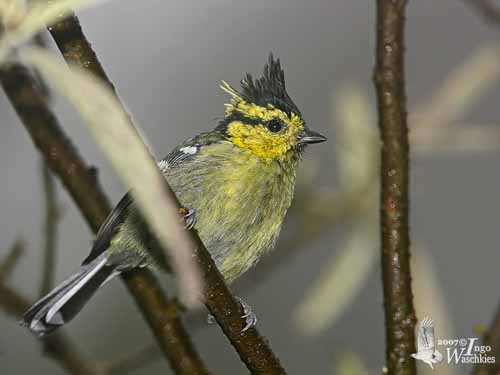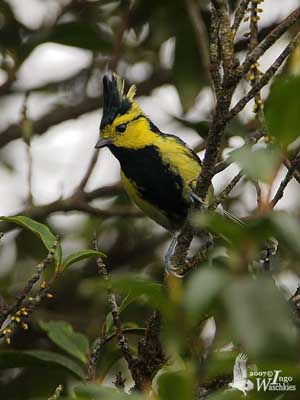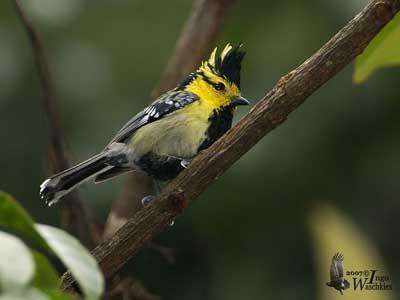
DIET:
The Yellow-cheeked Tit feeds on invertebrates and larvae, spiders, buds, some fruits and berries. It forages at low and mid-level of forest trees, and often in mixed groups outside the breeding season.
PROTECTION / THREATS / STATUS:
The Yellow-cheeked Tit can be locally common to rare according to the range.
The populations of this species are not currently threatened.
Fr: Mésange à dos tacheté.
All : Königsmeise
Esp: Carbonero Carigualdo Chino
Ital: Cincia gialla cinese
Nd: Geelwangmees
Sd: Östlig gyllenmes
Photographer:
Ingo Waschkies
My bird pictures on Pbase
Texte de Nicole Bouglouan
Sources:
HANDBOOK OF THE BIRDS OF THE WORLD Vol 12 by Josep del Hoyo-Andrew Elliott-David Christie - Lynx Edicions - ISBN: 8496553423
L’ENCYCLOPEDIE MONDIALE DES OISEAUX - Dr Christopher M. Perrins - BORDAS - ISBN: 2040185607
Arthur Grosset's Birds (Arthur Grosset)
BirdLife International (BirdLife International)
Wikipedia, the free encyclopaedia
XENO-CANTO – Sharing Birds sounds from around the world
Yellow-cheeked Tit
Machlolophus (Parus) spilonotus
Passeriforme Order – Paridae Family
BIOMETRICS:
Length: 14-15 cm
Weight: 18-23 g
DESCRIPTION:
This oriental tit shows prominent crest and contrasted colours. The Yellow-cheeked Tit occurs in montane forests from the Himalaya to Vietnam.
The adult male has olive-green upperparts with yellow wash. The rump is pale greyish. Mantle, back and scapular feathers have blackish centres. The tail is black with white outer webs on external rectrices.
The upperwing-coverts are black, whereas median and greater coverts are conspicuously tipped white. The flight feathers are blackish-grey. The tertials are broadly tipped white. The outer primaries have white bases forming small white panel on closed wings.

On the underparts, chin, throat, centre of breast and centre of belly are black with some blue gloss on throat and breast. Body sides and flanks are pale olive tinged yellowish. The undertail-coverts are dark grey with whitish tips. The underwing-coverts are blackish with broad white tips.
On the head, crown and erect crest are black as the nape sides. Face, cheeks, head sides and nape are yellow. The rear part of the crest is yellow too. We can see a black eye stripe from the eye to the rear of the ear-coverts.
The bill is blackish. The eyes are dark brown. Legs and feet are blue-grey.
The female is duller with pale yellowish wing-bars and greyish-olive bib.

The juvenile is similar to adult with duller crown, shorter crest and paler face and nape. On the duller upperparts, rump and uppertail-coverts are greyer. Upperwing is duller too. Cheeks and ear-coverts are pale yellow. We can see a small brownish-black bib in young male. Underparts are pale yellow with pale greyish flanks.
VOICE: SOUNDS BY XENO-CANTO
The Yellow-cheeked Tit’s calls include variations such as « si-si-si » or « si-si-pudi-pudi », also « tsee-tsee-tsee-si-si », and a different « ki-ki beer-ki-ki beer » repeated several times. We can also hear a combination of « witch-a witch-a witch-a » with a prolongated « churrr-r-r-r-r » and a harsher “krrank-it, krrank-it, krrank ».
The song is a ringing phrase of three repeated notes « chin-chin-piu, cha, chin-chin, piu, cha… » or also “dzi-dzi-pu, dzi-dzi-pu ».

HABITAT:
The Yellow-cheeked Tit breeds between 800 and 3000 metres of elevation according to the range. This species frequents montane forest, open temperate and deciduous or mixed forest with oak, pine and rhododendron, secondary forest, wooded cultivation’s edges, plantations and areas with scattered trees. In some parts of the range, it can be found in evergreen hill forest and large gardens.
This species is seen at lower level during the non-breeding season.
RANGE:
The Yellow-cheeked Tit is found in Bangladesh, Bhutan, China, Hong Kong, India, Laos, Burma, Nepal, Thailand and Vietnam.
BEHAVIOUR:
The Yellow-cheeked Tit feeds on small invertebrates and larvae, spiders, buds and some fruits and berries.
This bird is often seen in pairs or in small family groups.
Outside the breeding season, they forage in large flocks with other tits and small Timaliidae species. It forages at lower and mid-level of forest trees, but also in shrubs, bushes and undergrowth.
The Yellow-cheeked Tit is often confiding and fairly tame. It is noisy as other Paridae species, due to the social behaviour when they are foraging together.
The social status is often determinate by sex and age, with males dominating females, and adults which dominate the young birds.
The courtship displays involve head-up, to enhance the black bib of the male, while the crest is raised during these displays.
The male probably performs courtship feeding to the female.
The Yellow-cheeked Tit is resident in its range, but it usually performs altitudinal movements in winter.

FLIGHT:
The Yellow-cheeked Tit performs an undulating flight as other Parus species, and short flights with rapid wing-beats.
REPRODUCTION:
The breeding season occurs between late February and mid-August.
The Yellow-cheeked Tit nests in tree hole, rarely in walls or rocky banks. The nest is built inside the cavity. It is a platform made with moss, grass, leaves, fur, wool and feathers. Some other materials such as flower petals or snakeskin are added if available close to the nest-site. The hole is placed at about 15 metres above the ground.
The female lays 4-6 eggs. The nesting behaviour of this species is unknown.
